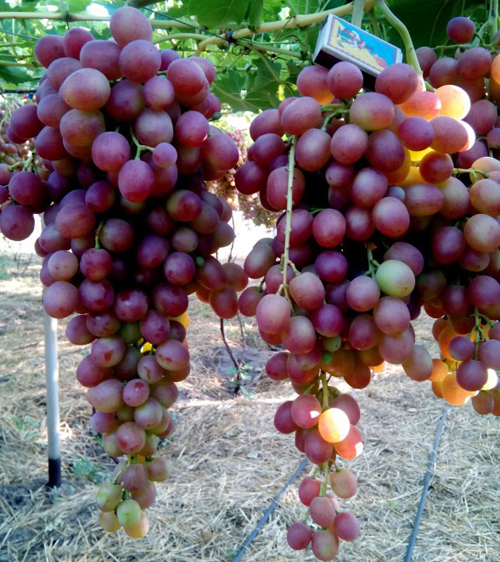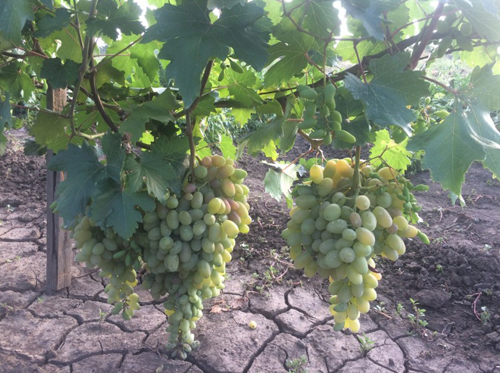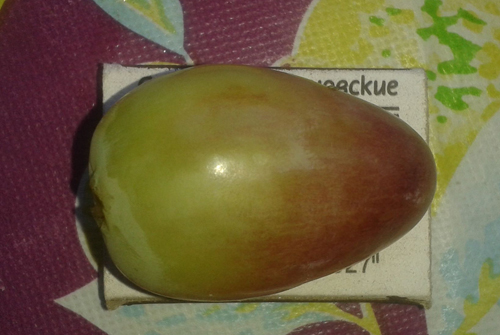Grape variety Transfiguration
The development of new grape varieties has long ceased to be the exclusive prerogative of scientific research institutions. More and more enthusiastic amateurs themselves undertake to master the craft of a breeder in order to enrich the varietal fund of this wonderful plant. Due to the wide variety of properties of the vine, the possibilities of its hybridization are truly endless, and the result of this work depends solely on the inspiration and perseverance of the vintner-creator.

One of the pioneers of folk selection in our country can be considered Viktor Nikolaevich Krainov from Novocherkassk. Hundreds of followers have followed in his footsteps, for whom the effectiveness of Viktor Nikolaevich's work still remains a guideline and an example to follow. In the assets of Viktor Krainov, there are many new hybrid forms that he developed, highly appreciated in amateur viticulture, and even in demand in industrial.
One of these hybrids that have found a permanent residence permit on personal plots is Transfiguration. This variety is included in the so-called "Krainov's three" - forms very similar to each other, bred at one time by an amateur originator. In addition to the Transfiguration, the same list includes such varieties as Victor and Anniversary of Novocherkassk. In appearance, all three varieties are similar like two drops of water. There is an opinion that they are all clones of the same hybrid, however, to find out whether this is so or not, probably it will not work, their author is no longer with us.

Our hero was obtained on the basis of hybridization of two well-known and popular varieties - Mascot and Radiant kishmish... Seedless grapes from this crossing did not work, but even with seeds, the new form impresses with the size, color and beauty of the bunches and berries. It was they who became her hallmark, predetermining the admiration and enduring interest in her cultivation on the part of the admirers of grapes. From the Talisman, the new hybrid inherited the outstanding large-fruitedness, and from the radiant Kishmish - the elegant pink color of the berries.
Shrubs of the Transfiguration are distinguished by a very strong growth. The leaves are large, green, medium dissected, five-lobed. The upper lateral notches are open and deep. Lower lateral open, barely outlined. The petiole is open, with parallel sides and a flat bottom. The flowers are bisexual and do not require pollinators.

The bunches of the variety are very large - from one and a half to two kilograms, some reach a mass of 3 kg. They are conical or cylindro-conical, sometimes shapeless. The density of the brushes is medium or loose. The comb is strong, green in color. The berries are well kept on the ridge by the legs of medium length, no squeezing is observed. The berries themselves are very large, 36 × 24 mm in size and weighing up to 20 grams, elongated-oval, with an easily eaten skin of medium thickness, a pleasant pink color, covered with a white layer of pruin bloom. The taste of the Transfiguration is sweet and sour, harmonious, without pronounced varietal characteristics. The pulp is juicy, fleshy, medium density. The seeds are present, but in berries of such a large size, they are almost invisible when consumed. In the case of an overload of the bushes with a crop, to which this vigorous hybrid is prone, a decrease in the taste of the grapes is noted up to a completely inexpressive watery state.

The crop ripens very early - 110-115 days after the beginning of the growing season, is used for fresh consumption, is of great interest and demand from buyers.Suitable for long distance transportation. Taking into account the early maturity, the grapes have time to ripen in various climatic conditions, and in the very south, according to some estimates, they even manage to get a second harvest on the stepchildren. At the same time, the variety has a specific feature - the most intensely colored and spectacular-looking bunches grow in the shade and in the northern regions, not too spoiled by the sun. For this reason, it is recommended not to lighten the bunches on the vine too much in order to achieve the best berry attractiveness.
The fruiting of the Transfiguration is very abundant. You can collect up to twenty kilograms of berries from a bush. Ripening of shoots is satisfactory. The sugar content of the grapes is good - 17-19%. Acidity 6-8 grams per cubic decimeter. According to some estimates, bunches can persist for a long time (in the south until October) on the bush, only slightly withering, but also becoming much sweeter from this than at the time of ripening.
The agrotechnical features of the variety are medium, and according to a number of evidences, insufficient frost resistance, lack of resistance to diseases and pests, high stepson formation, tendency to thickening and overloading. To obtain a high-quality crop, it is recommended to leave no more than one bunch on the Transfiguration shoot. It also gives good results when pinching the lower part of the hand by one quarter or one third. It is necessary to carry out such a procedure immediately after the start of berry growth, when they do not yet exceed the size of a pea.
At the same time, this hybrid has a good rooting rate of cuttings and fusion with rootstocks. It grows rapidly and begins to bear fruit. Peeling on the hands is rare. The grapes are unstable to phylloxera, therefore propagation by cuttings is possible only in areas free from this pest. Wasps are moderately damaged.
In general, the Transfiguration can be considered a very refined, but at the same time, a rather delicate variety. By and large, this is a problem of many amateur breeding hybrids, where parental forms are often chosen with only one idea - to obtain a bunch that is unique in aesthetics as a result. At the same time, even taste fades into the background, and agrotechnical characteristics are sometimes completely ignored.
The transformation, fortunately, with really outstanding indicators of the quality of the crop, cannot be called completely greenhouse grapes, but the necessary agrotechnical recommendations must be followed very responsibly and in full, starting from planting seedlings and choosing a form of bush management, ending with caring for adult plants during the fruiting period. Particular attention should be paid to assessing the climatic conditions in your region, whether it is necessary and possible to protect the vines from frost damage, and seriously approach the treatment of plants from pests and diseases. It is also important to carry out correct load rationing, pruning and green operations in order to avoid overloading and excessive thickening of the bushes. The transformation, in turn, will surely appreciate the efforts of a competent winegrower, thanking them for the care of the stunningly beautiful bunches of the harvest.









I admire this grape. This is one of the favorites on our site. A commercial grade that has a dedicated fan base.
We have all the “representatives” of the Krainov Troika, but Transfiguration is the leader among them. I affirm that these hybrid forms differ primarily in the shape of the berries.Viktor has the smallest one, YUN has a barrel-shaped, huge, simple, and the Transfiguration is dominated by a conical shape.
The taste of the Transfiguration is simple, sweet, without nutmeg, but the bunch is very elegant and attractive. We give the load on an adult bush about 18 kg, since this grape does not like overloads (he was greedy - the bunch will not color well, the berry will be watery and herbal to taste). It is imperative to cover for the winter, carry out treatments regularly, then the Transfiguration will show itself in all its glory.